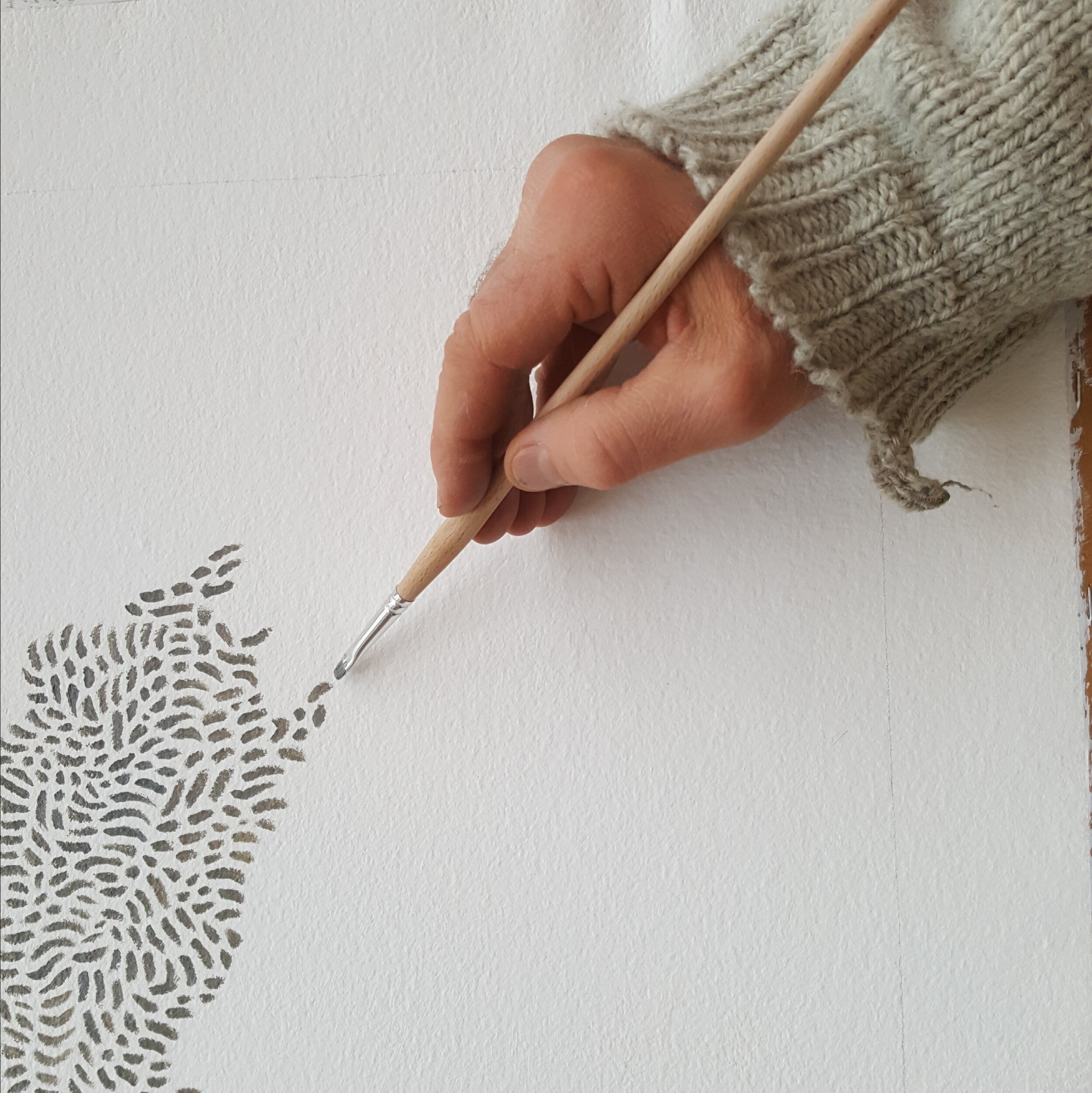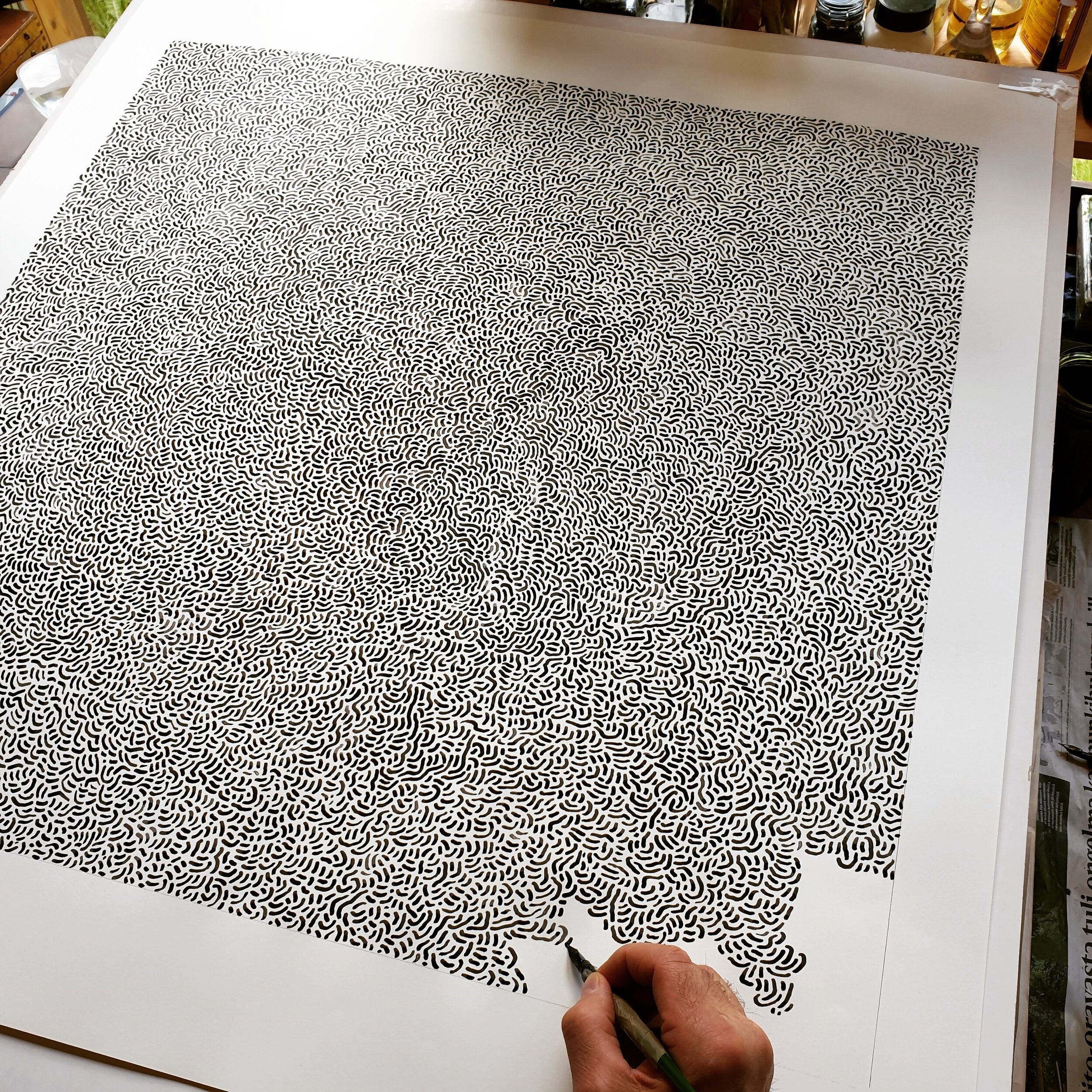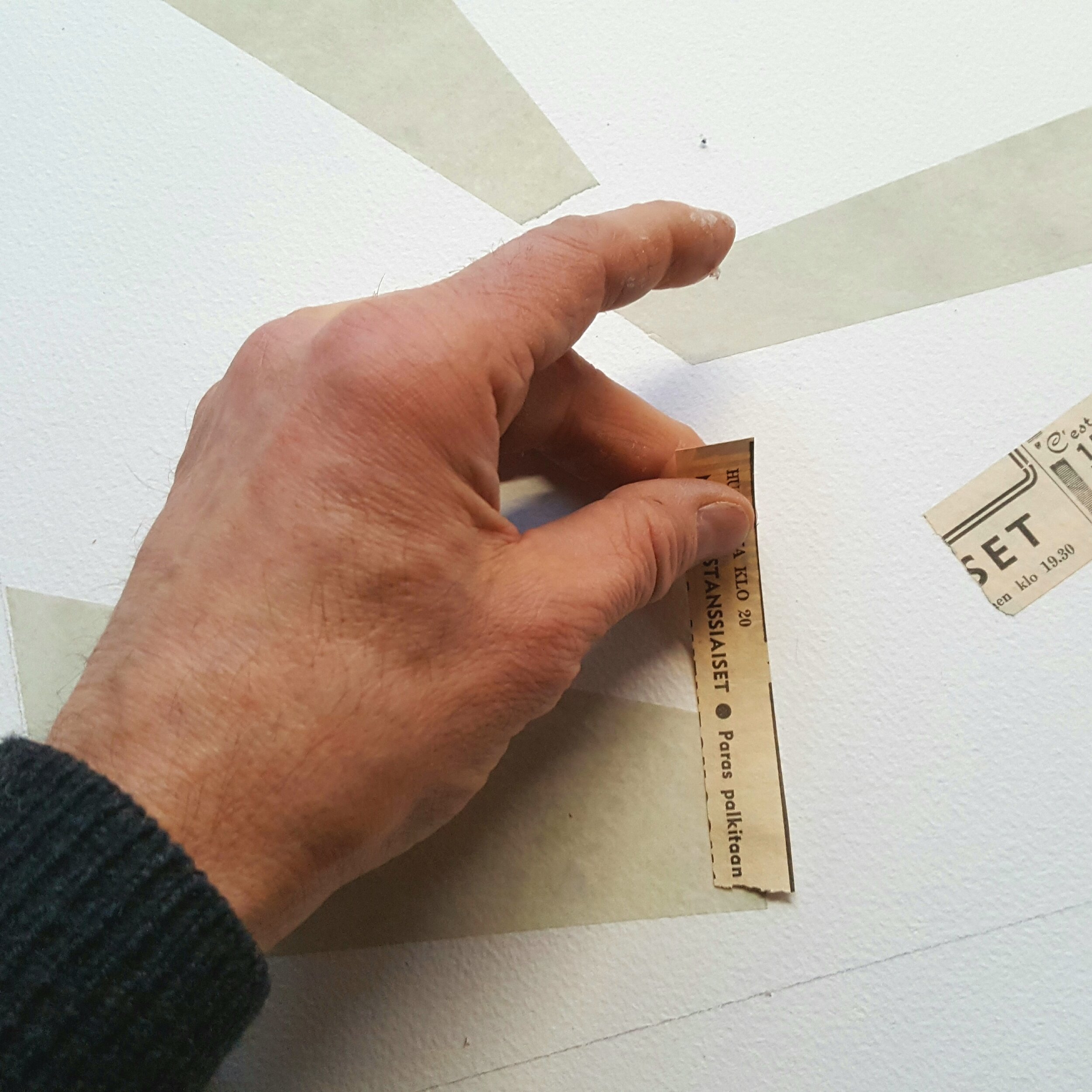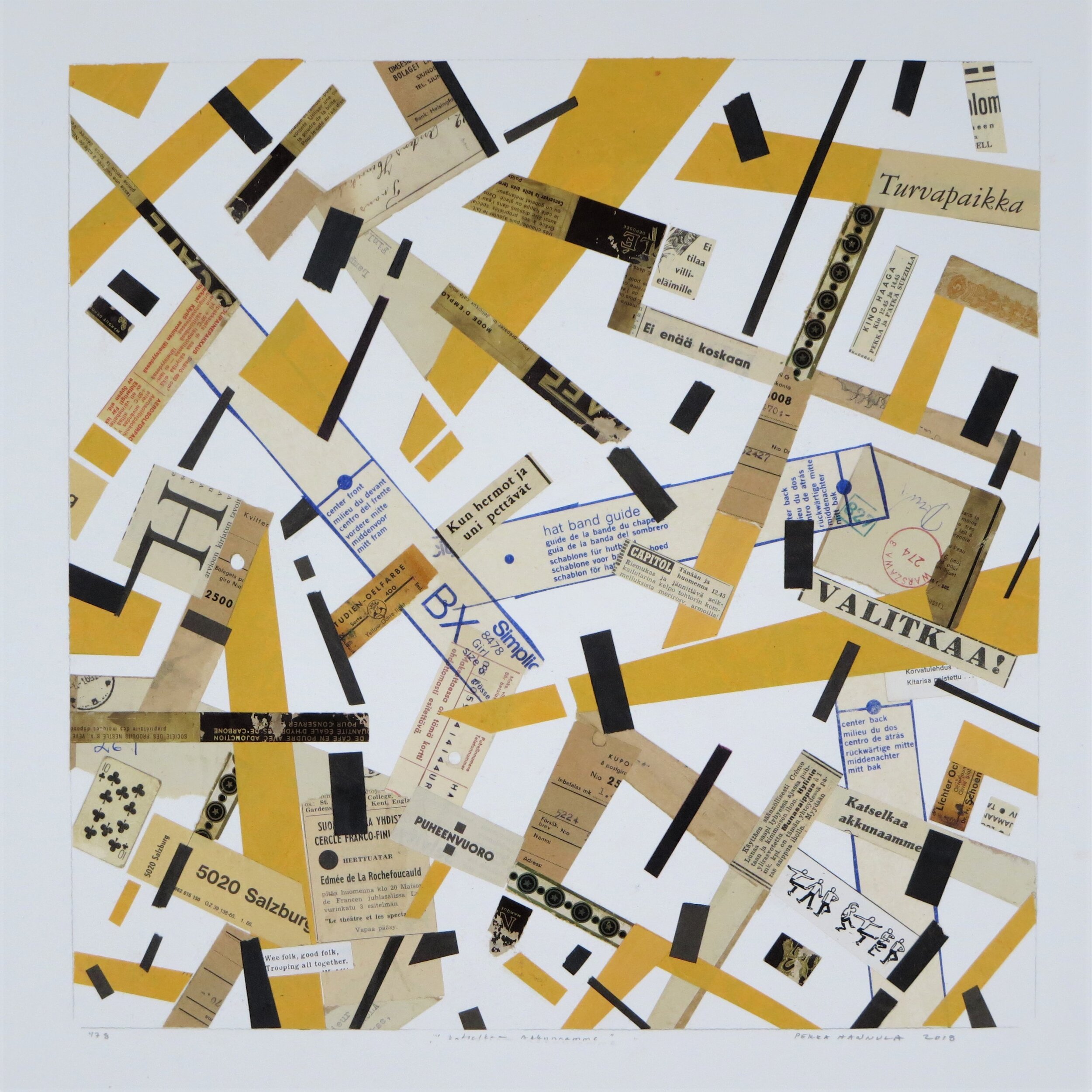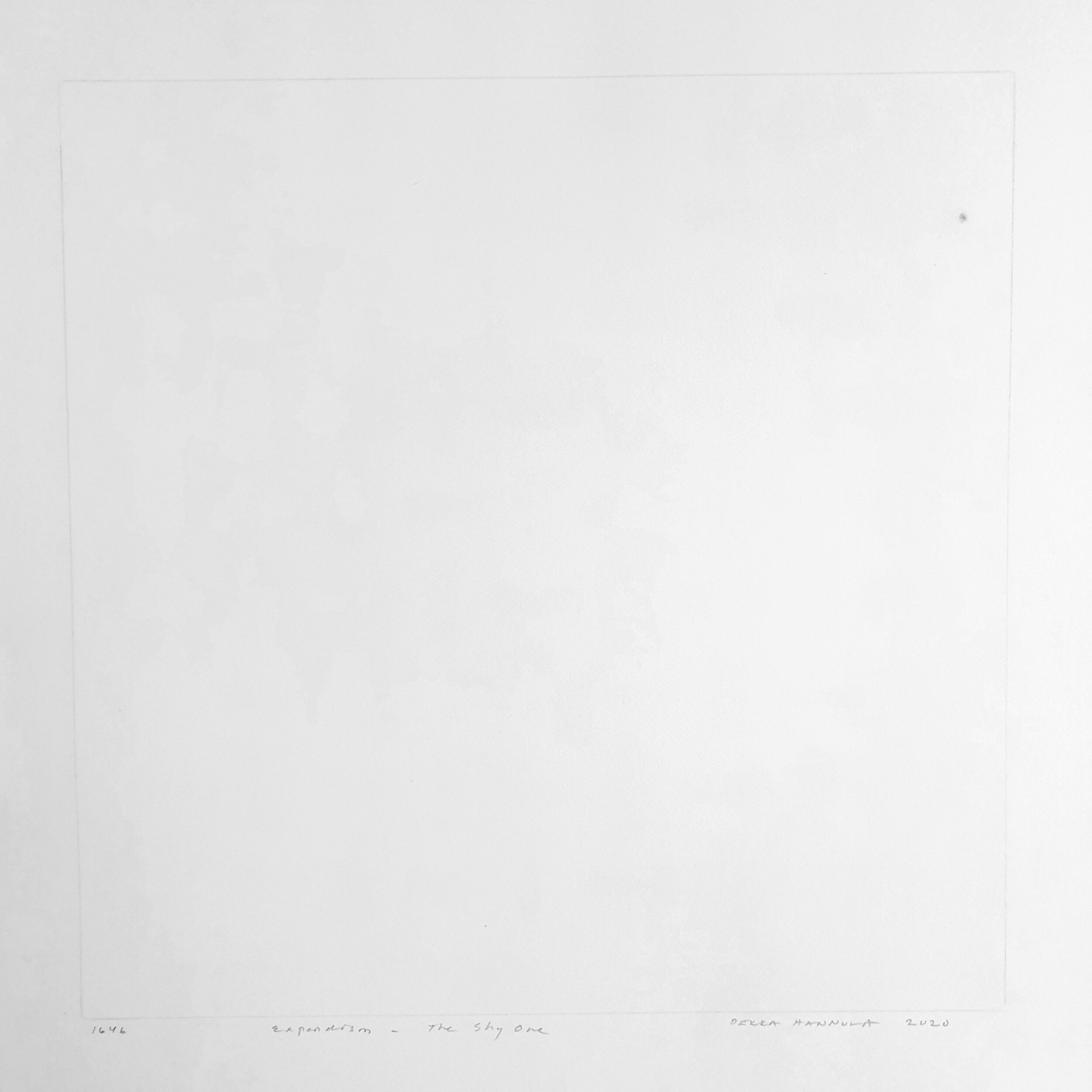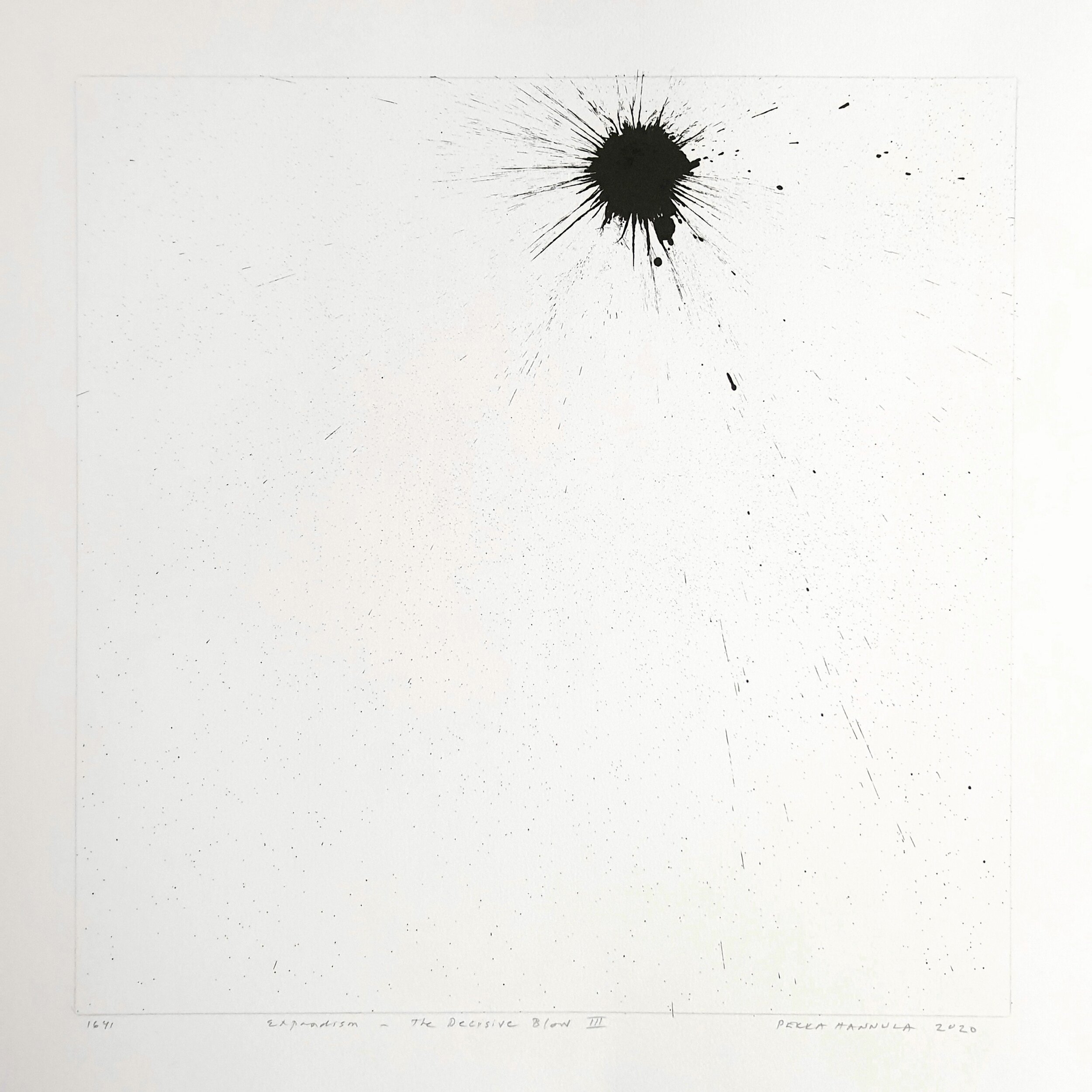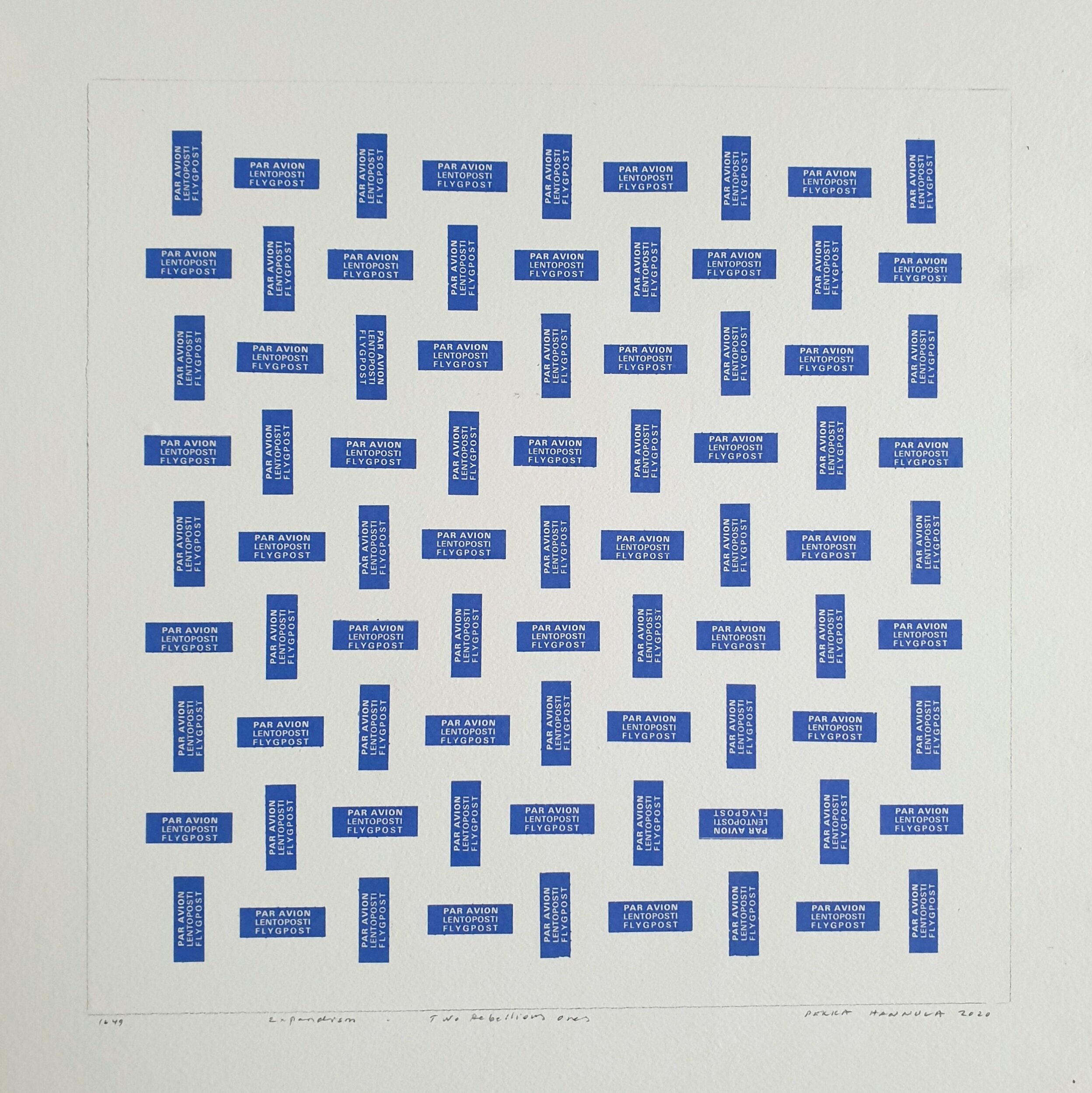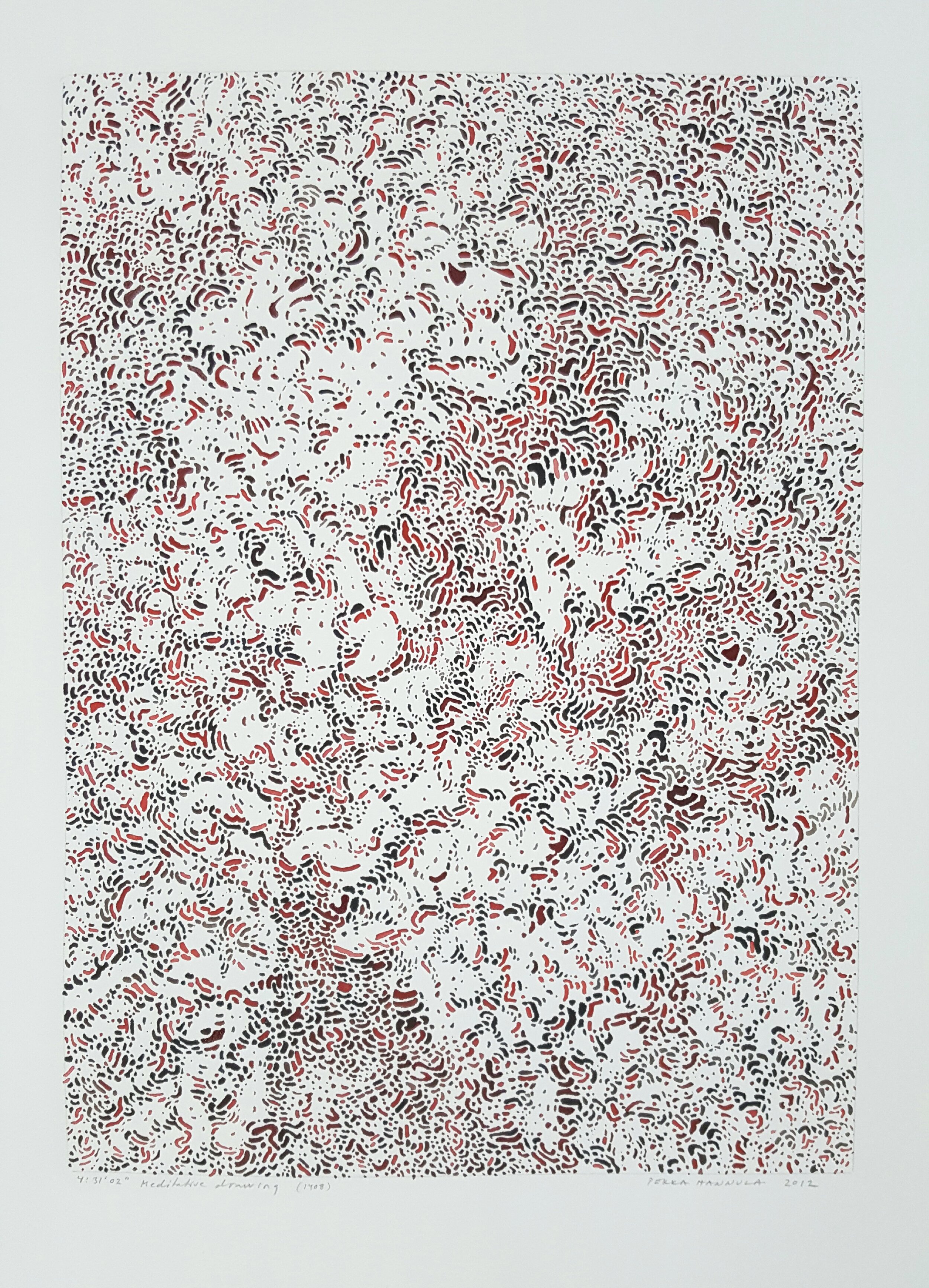Pekka Hannula
Expandism – Expansion Motivated Art
Introduction
This article is a compact study of expansion in the context of making a piece of art. I believe that expansion is one aspect of all kinds of making of art. It has been neglected topic, even unseen, but the phenomenon is real and it is connected to art making, for it is impossible to make a piece of art without its expansion to some space. A work of art is always located in some space – on paper or canvas, in real or imaginary place, in this world or in digital one – and a work of art must first enter that space, it must do aesthetic-expansion there to take control of it. And it is the artist's task to make this happen.
By definition expansion means the increase of something in size, number, or importance. It relates to artworks in two ways, first, to the actual size of an artwork, and second, to the making process of an artwork. In some cases these expansions are overlapping, like with installations where the piece of art is made directly into some space or room. My main interest in this presentation as a visual artist is to focus on expansion which relates to the working process, and not so much to artwork’s size-related expansion.
But, every artwork has its ideal size in where it is at its best. Making a piece of art is like blowing air to the balloon, estimating how large it is necessary to let the balloon expand. The important thing here is to ensure artwork’s best possible condition to make a best impact on the audience, and to find its ideal size in both ways. As an artist I don’t see what is the point of doing artworks otherwise. Here stands the art’s connection to rhetoric which is the art of persuasion. Per se, a piece of art must be a convincing one.
Many art related questions are aesthetic ones which are associated with individual personal taste – even questions like defining the right size for the work – and there will never be precise tools for measuring these. But thinking about expansion, and trying to understand it, helps artist to find the ideal state of presenting hers/his work in some particular context. So, it is important to give expansion a thought. What is the best possible expansion of an artwork? – from inside and towards its environment – is a question of quality for the artist to aim at. This is a taste related standard for a good artwork, and it is a mental tool for artists to understand this target. And for these reasons aesthetic-expansion is worth studying.
Expansion is not the only motivator behind an artist's actions, and perhaps it is not a motivator at all, but a phenomenon which happens in art-making and is mingled into the need of finishing off the work. I think the main motivators of an artist's actions are a need to do something beautiful or good - meaning something s/he likes or something important - and a need to get the artwork done pursuing that goal. Expansion is a phenomenon which happens when artwork is reaching its limits from inside and with interplay towards the outside world. It is an assessment tool for adjusting artwork into the artworld and for making right decisions for making a good artwork.
But expansion is also a method of art-making. Expandism is a term I use for expansion-motivated art, art where expansion is a very strong factor in the making process. It is art done using repetition and composition as tools to do expansion, which at some cases continues till the end of the working process. I invented the term 2010 when I started to do drawings in a repetitive manner, drawing what I call meditative, reduced or repetition based ones. Soon after that I started to do paper-collages testing expansion-idea by playing with the composition, that is, playing with shapes (the pieces of paper) the game of arranging. In Finnish I have named the expansion-motivated art to ekspandismi.
I like to highlight two books which have affected this writing. First I mention John Dewey's pragmatism thinking and his book Art As Experience to which I return on a regular basis. For example his views of how an artist is doing composition, and many other views are compatible with this text. He has definitely influenced my thinking. Another important book is Deanna Petherbridge’s large presentation The Primacy of Drawing – Histories and Theories of Practice. Drawing was a starting point for this modest theory of mine and through drawing I keep on developing it further. I see this study as a direct answer to her wish that drawing needs to be reaffirmed as thinking. This I have tried to do.
Expansion – an unnoticeable factor in making of art
Expansion means that some matter – like phenomenon, people, nation, disease, ideology etc. – is conquering to itself more space, its sphere is expanding. There is the expansion of the universe and expansion is also connected to mathematical and other theories. In the natural world, expansion is evident for example in formation of cell tissue, which is based on the dividing process of cells. But expansion is part of the art-making process too.
The making of a piece of art is a multifaceted task. There is a craft aspect of the working – the ways how the things are done, the mastery of techniques and knowledge of the materials. And there is a physical aspect of the activity – artist’s reactions to the environment through her/his own body. And there is an aesthetic aspect also involved in this – how the composition is arranged and the measurements done, how the color is tuned to fit in to the whole and how to present the message – If there is any – in the best way, etc. And maybe there are also other facets in making a piece of art, for example mental ones, but this is not important. The main point here is only to locate aesthetic-expansion close to composition. It belongs to the realm of composition and it comes very apparent through repetition, which is one instrument – like harmony, balance, rhythm, proportion, scale, etc – for making composition. Composition means “putting together.” It is the organization of the elements of art, the artist had put together, designed for hers/his artwork. It is the way that people or things are arranged in a painting or photograph.
Expansion starts right away with artist’s actions – like when s/he starts to draw lines on the paper – and it continues more or less till the composition is arranged or even till the end of the working. Of the elements of art expansion is particularly associated with line, shape, space and color, not so much with form, value and texture. Shortly, line includes also dots, and shape is a bounded two-dimensional form, like a one paper piece on a work of collage, and space deals with distances between shapes and lines drawn on the paper. These four are more actively used when expansion is proceeding on the canvas. I don’t want to state that the other three has nothing to do with expansion because in reality in art-making the elements of art are not used separately but simultaneously. Not even repetitive drawing – which is done by repeating simple lines – can’t be done without thinking of space between lines, and texture is also distinct if the drawing is done with oil paint. And value can also be an important matter in composition, because darker and more intensive areas of colour get attention.
To what space is the work of art expanding? Where does this space locate? For me – and for many artists – the space is simply the two-dimensional flat surface on paper or canvas, or other hand touchable area, platform or place. Shapes, color and lines are simply expanding, spreading into that area. In the realm of visual art this is a more easier question to see than, for example in literature, music, theatre and other fields where a piece of art is more a mental than physical object. In visual art there has to be a limited space for expansion, to make it happen and for me that space is quite often a bounded square area on the drawing paper. If the space is restricted to some terrain –park, field, nature etc – expansion proceeds within that, which is obvious with public statues and in many cases of environmental art and with multiple component sculptures. In these “the canvas” is just bigger and a bit more difficult to define.
When I draw it is possible to keep on adding new lines side by side and top of each other in layers till the paper is entirely covered with ink and the area becomes black. So, the outcome of this expansion seems to be blackness. I think that the question, when the artwork is finished, is entirely up to the artist and hers/his choices. It is a question of the aesthetic goals the artist is trying to reach. But in general, when shapes and lines are arranged or at latest when the first tentative layer of color has been spread, expansion has practically reached its limits. After that everything is just decoration of that expansion.
This is true also with the meditative drawings if I continue to draw new layers of lines on the top of the first one. When I draw I normally cover the surface with lines only once. And at this point the expansion is done. And even if I’m not happy with the result and decide to cover the drawing with another layer of lines, expansion doesn’t change so much because all paper was already occupied with lines. And when I continue working my focus is on the general outlook of the drawing and matters like cohesion and texture. A meditative drawing doesn't have an underlying composition, but composition is built up simultaneously with drawing and very often it is ready when all lines have been drawn.
I tend to think that the expansion is largely finished when the structure of composition is arranged. And sometimes, like with repetition style drawings, this happens at same time as completion of the drawing. I leave the planning and preparing aspects of an art work outside of this study. The philosophical and brain research question of when the action begins – before or with the visible action – is not in my keen interest either.
Two ways of expansion in art-making
Next I will look more closely at two kinds of aesthetic-expansions relating in making a work of art – repetition and composition – which, I believe, are two main ways to explain how expansion happens in the field of art-making.
Expansion by repetition
A good way to demonstrate expansion is by taking a reduced way to draw as an example. This means that the drawing is done by using simple marks, lines or dots. Drawing process begins spontaneously on some spot on the paper by making simple lines on the paper side by side in a repeating manner. Repetition means here that something that has been done earlier is done again. When repetition of lines continues the area of lines grows bigger and the drawing slowly keeps on expanding till the lines are covering all the paper and the drawing is complete. In other words, expansion happens by the increase of the number of the lines. This can be done also with colors, then the outcome is more like an abstract painting than a drawing.
To contemplate around lines, to search for a relaxing state of mind by repetition is important to me when I work, but it is not the main goal here. The concept of expansion also encases the idea of the conquered area as a goal. The goal of finished, completely filled paper is right there at the very beginning of the expansion. So the main point is to finish off the work. This is the driving force behind the expansion. The meditative state of mind is an aspect of my personal style of working, a feeling or a side effect of this kind of repetitive working, which has very little to do with the actual expansion I am explaining here. But it helps to perform the monotonous act of drawing, which might go on for days or longer if the piece of work is a big one. This has connection to virtue, or to effortless action, to the right kind of drawing action which is easy to perform.
I normally start to execute this kind of drawing spontaneously without planning the outcome beforehand. I just follow some simple idea of how I should draw the lines – direction, curvature, rhythm, space and distance between lines etc. – and then I just keep on varying this idea and adding more lines on the paper. And through this repetition of marks the drawing gradually expands into its whole. When the last line is drawn the expansion is complete. This is a definite example of the expansion in art-making.
The repetition based drawing process does not on every time lead to a good piece of art. Because, at least for me, it is integral to contemplate around lines, and also because it is possible to make bad choices at the beginning and those choices make direction of actions to lead “aesthetically” to the unsatisfying outcome. I think that a piece of art, a good drawing, is a gift that sometimes emerges at the end of the process. And when this happens – when a new piece of expandism art comes into daylight – this is always a moment of surprise and joy. For me, good in this context means a drawing who is formed by a vibrant mass of lines like a living organism. This line organism is a result of contemplative drawing activity, and something from that state of mind had transformed – I hope – into the drawing.
Expansion by composition
So, when I draw I use repetition as a tool for expansion. But there is also another way to achieve expansion and conquer the empty paper. This happens by using composition as a tool. This kind of expansion is very evident in paper collage making, because arranging the paper pieces – shapes – continues till the end of the working process. But this fits to other techniques too.
When I make a collage, from the start I try to glue the first shape – a piece of paper – to the right place on the paper and next pieces to the best places to improve the burgeoning arrangement. This is like a military strategy in which the expansion is done by taking first the most important locations under the control. I continue working by positioning next paper fragments to the right places to make composition even better.
Some subconscious idea of what is a good arrangement of pieces seems to steer my actions. So, the expansion starts right away by trying to win the crucial spots on the paper and it becomes more evident and deepens as working proceeds further with minor details. This continues as long as the combination looks ready, and all parts are in their right places, which is purely a personal question of taste. But all the area has been taken aesthetically under the control.
The collage making process is a kind of conversation or a game, in which the player is trying to find the best arrangement using the material at hand. The game starts when the first fragment is glued, which changes the situation on the paper. It is no more blank but nascent composition. New situation challenges me to make my next move. So, I put the next pieces of paper on the surface and the composition starts to take shape as I keep on working by reacting to new challenges the composition makes. This is like having a conversation between an artist and the developing composition, which continues as long the work is completed.
Expansion-motivated art
As I have said, I call expansion-motivated art expandism. The most evident case of expandism is an artwork done with repetition style – like a meditative drawing I have introduced. In those, expansion proceeds slowly together with repetition, and expansion of the drawn area continues till the paper is covered with lines. Repetition is a good instrument for doing expansion but it is not precisely the correct notion here. Lines and shapes that are drawn or painted on the paper or canvas need not to be the same kind ones, but can vary a lot and be even contradictory ones. It is not necessary to repeat the same shape of a line or its variations. Expansion is a step by step spreading process, in which an artist is gradually and systematically covering the surface by lines or by colors, figures, dots, or by whatever s/he wants to. And expansion is a strong motivator of this activity. Goal is to cover the white surface gradually by repeating a simple dot or bit by bit adding something more complicated on the canvas.
The other possibility is to do expansion by using composition as a tool for expansion, like in the collages I have introduced. In these too, expansion is a strong factor of motivation. But nevertheless, this is not so clear like in artworks made based on bit by bit proceeding expansion. This is because other motivators – form, depicting, perspective, message etc. – are coming into the art making process, and these are getting stronger when the working process goes forward. In collage making the presence of expansion as a motivation is clear at the beginning, especially if there is just pieces of paper and other fragments (shapes) you are playing with. But right after there is a topic or various colours you like to deal with, expansion is no longer the only important inducement you have. At the beginning of the working process, the expanding, the need to spread the elements of a composition to the right places on the canvas is very obvious, but towards the end other motivators – like unity, beauty and meaning – play a more important role.
This is more evident in figurative paintings. The reason why I don’t see them as expansion-motivated art relates to the motives of an artist. If the goal is to do – say, landscape or portrait painting – with a certain style, then expansion is more obvious at the beginning of the working process when the artist is sketching the composition on the canvas, taking it over. But the expansion is not the only motivator of actions but it is among many others, like imitation and depiction, and it goes less important as the working process proceeds. Artists must proceed with a topic and message in mind and arrange shapes and lines on that basis. So, expansion is a phenomenon which only happens in the background. Expansion is most evident in monochrome drawings done by repeating simple lines or dots. In these the area of dots is expanding slowly covering the surface. But when colours are involving to the task, they are starting to compete or be in relation against each other and the artist's motivation is no more in doing expansion but in balancing the colours to fit to the whole.
In theory it is possible to do an abstract painting in a spreading manner, by letting colours to expand over the surface or like playing the composition game using colours, that is, placing them on the right spots on the canvas. But in reality colours – and all other elements in composition – are requiring attention and s/he has to focus on colours, values, shapes and forms and to balance them to fit each other and the whole. There is warmness and coldness, and different shapes get more attention than others. There are many concurrent developments among pairs of contestations, like lightness vs darkness, big vs small, pointed vs curved etc, that there is no point to even try to separate expansion from these. Making a more complex piece of art is a task of balancing and that drives the artist's motivation, and expansion is not an important motivator here. It is a phenomenon which happened when composition had been arranged. Even in very simple paintings, done by few colors, it is difficult to discern the expansion. In expansion-motivated art expansion is evident and it is easy to detect during the working process.
Also it is possible to construct a three-dimensional collage using objects, that is, to do a sculpture by adding to it new pieces till it is finished. However, this is not an expansion driven activity, but the artist's attention is fixed to the form. But there is a connection. Sculpture making is like chiseling just one dot on the drawing paper to conquer the drawing area. Sure this is expansion, especially in the context of public art. But in general, singular object-like sculpture's contact to expansion relates its size, not to the working process per se.
Expansion is most evident in art based on some form of repetition, as I have described above, but even in these it is not the only motivator of actions, and there might be many hidden or subconscious motivations also, ranging from harmony to testing of ink. Anyway, expansion as an essential motivator fits best to these and other abstract art styles, in which you are filling the canvas and creative acts are expanding to artwork’s space systematically in some inventive way. A meditative drawing and similar styles, based on repetition, in various techniques, in which expansion is happening simultaneously with drawing, these are obvious cases. It is possible to see how expansion is taking place. But after that the border between expansion-motivated and other art is a composition-related speculative question.
Some theoretical viewpoints and sidetracks on the topic
1. One drop expansion
But what is it to do expansion to some space? What does it mean to conquer some area? In a theoretical sense it seems that aesthetic-expansion needs only a one drop of ink or one glued piece of paper to take control over white surface of the paper. But in the long run that kind of art making is not very interesting. To do something more satisfying, in contemplative and creative sense, needs a much more complicated and longer lasting process. One stroke of a pen does not have much to do with the idea of repetition either. Unless the artist doesn't continue to do these one stroke drawings as a series of them. This kind of serial way of repetition – a serial way to do drawings and artworks – is expansion too. And it is possible to think of an artist's all production, all hers works as some other sort of expansion. But here I like to limit expansion only into singular pieces of art and think about this phenomenon through this.
A small dot on a fringe area.
In theory the one drop expansion offers interesting angels here. If I want to take control of the drawing area with just one mark then the mark must be strong enough to make the effect and it must be located in the right place. From the fringe area the modest dot can't control all the area and then the expansion seems to stay unfinished. But in the middle it makes a difference and the expansion is done – or should I say the occupation of the paper is ready.
A small dot in the middle controls the whole area.
When the drop of ink is bigger and the artist's action more decisive one, then the location doesn't matter so much to make an aesthetic-expansion complete. The expansion starts and ends with a one blow. The more delicate the mark is the more location matters to make expansion complete. A modest disturbing element on the fringe area is a beginning of expansion, which needs more actions to come complete. A completed expansion seems to be a matter of taste, not a universal undeniable fact.
Also naming affects expansion and to that how we are experiencing the work of art. The ultimate example of this might be an empty drawing “The Emptiness”, an untouchable piece of paper. Obviously paper has been occupied by emptiness and expansion is done. Artist signature seems to be the final seal of an expansion.
2. Meditative aspect
So, what is this meditative or contemplative state of mind I am talking about? For me It is a mental mood in which artistic actions are easy to perform. Drawing comes effortless and you just know what to do next when working with other techniques. It is a meditative state in which you do lines almost automatically. This has similarities with surrealist automatism and there is kinship to improvisation too, especially in drawings. The lines are often done by varying and improvising around some pattern. I don't want to state that this is pure flow, because the action might last quite a long time, even hours at a time and for me it is impossible to maintain the state of flow all that time. But flow is definitely part of this, giving extra boost to the action from time to time. I deem that all kinds of drawing activities are also thinking. Drawing is a tool for thinking and if I draw I am in my thoughts using my pen, brush or whatever medium. That’s why I call this to contemplation.
When I draw I concentrate to execute well-done lines. It is to focus on the task and a kind of meditation. For me there is no spiritual or religious connotation in expandism. So, the term contemplation fits this context best. When I draw I’m in my thoughts, and those thoughts are fixed to those lines I'm drawing. This is what I mean by this contemplation. The meditative and contemplative aspect is a kind of side effect which emerges when repetition of the easy lines continues long enough. But sure, the meditation aspect is right there, behind the corner. By combining breathing to the rhythm of the drawing process makes the activity very meditative and also relaxing.
3. Repetition and creativity
Repetition is not a new thing in art making. Aboriginal art is very much based on repetition and many artists have used repetition as a part of their art or in some of their works, like Yayoi Kusama or Andy Warhol. Repetition brings up interesting questions of arts relation to creativity. It seems that doing an artwork based on repetition needs not much creative thinking but just doing repetition. So, what is a piece of art? A fruit of creativity or something else? When there is “no” improvisation influencing the repetition and you are just repeating the same, then it is quite mechanical, which is something opposite than creativity. I put “no'' inside the question marks because I don’t believe that a human being can do purely mechanical repetition even if s/he tries.
Repetition by airmail stamps.
When, example, similar airmail stamps are glued very precisely on the paper every gluing act is different, and every stamp has alterations caused by the gluing process. And even if everything looks precisely done, uninventive and mechanical, the working process might be opposite. Perhaps an artist had invented new ways for doing stages better or invented new ideas while working. So, as long as there is a human hand – a human factor – mixed into the repetition process, there is at least a drop of creativity in it. A human being can’t be a machine even s/he tries. If the work of art looks like an uncreative one it doesn't mean that the working process has been uncreative.
4. Size
As I said earlier every artwork has the ideal size in where it makes the best impact, and the artist must find out and decide what that good size is for the artwork s/he is making. The right size is an important attribute of an artwork. But there is an interesting phenomenon relating to this. A small size drawing done with repeating simple lines does not affect the beholder like correspondingly made a wall-like big one. This is because we are experiencing artworks through our body and a big one changes our environment more than a small one. When we are experiencing an artwork we are making it proportionally to our body. Seeing a big size artwork resembles an environmental experience and that is why it does have a stronger impact. Sure it is impossible to better all artworks just by making them bigger, but this is the area of art tricking where the only substance of an artwork is the size.
But anyway, it seems that big artworks are more and more dominating exhibition spaces all over the world. One reason behind this development is the exhibition spaces it-selves. Many artists are doing their works primarily to these spaces and this affects the size. Doing art for normal homes requires a much smaller scale. Also there is a lot of competition between artists and museums, and this favors the bigger size, which is more noteworthy than a small size. In addition there is a development which brings museums closer to “amusement parks” for there is demand for ever more “better” experiences. A bigger artwork helps in this much easier.
So, artwork's optimal expansion depends on the context. The artwork’s size can’t be whatever. The actual size has restrictions set by the location – the wall is as big as it is – or there is a certain sum of money, the budget, into which the artwork must fit in. And maybe there are practical reasons limiting the size, like the size of the artist's car or atelier space. The size-related expansion has always limits.
5. Space of experience
I mentioned that in some areas of art there are invisible spaces for artworks to expand and these mental spaces might be difficult to define, like in literature or in dramatic art. Also in photography it is a more tricky question to answer how expansion happens in the creative process which might be over in a second. In John Dewey’s pragmatism the answer to this question relates to our experiences of art. With this I don't mean my emotions or experiences in general but those experiences I have had when I had completed satisfying artwork, seen well done works of others, and had inspiring fulfilling moments with artworks. This - an experience - is more than a feeling, it is an in-built understanding of the essence of an artwork. It is something I gather along the way experiencing all kinds of art. The essence of art is experience.
So, the actual space or area for various kinds of artworks, in whatever fields of art, is a mental one. It is a location of satisfying experience of an artwork. And to this space an artwork must do its expansion. Sure, a personal taste is affecting this, but anyway, the essence of the space is a mental one. Into that space a writer expands her/his story searching its limits weeding out futile sentences, and a photographer does his cropping based on all cropping s/he had done and experienced earlier. This is also true in painting and drawing. Even If the space of expansion is visible the essence of it is a mental one. And an artist can give beholder direction to there, by naming a piece of art properly.
These spaces are conceptual ones, they are structured styles of thought, the ways of thinking that are familiar to certain groups, like artists. There are conceptual spaces for doing repetitive style drawings, and spaces to draw and paint in different styles and make collages of various kinds. Artworks are expanding to these and within these spaces. Important question here is how to pursue the best possible aesthetic-expansion to that space. A good starting point is to make differently, and try to find something not experienced before, even if every style has its own limits – a simplified line is a simplified line, and (perhaps) nothing more. But this is anyway the direction in which something creative may happen. In reality, though, in art-making, change happens very slowly. It is an evolution-like process where change happens gradually, a new piece of art is done with the help of previous ones, and the next one is buttressed by the latest one. However, creativity is a good target to aim.
Conclusions
Above I have introduced expansion as an artwork related phenomenon. The phenomenon is real as I have shown, and it is associated with all kinds of visual art. However my interest here has been studying it in the context of artworks on paper and canvas. Aesthetic-expansion is detectable in artwork’s making process in relation with repetition and composition. In the making process of an artwork expansion has especially strong connection to repetition – drawing or painting which is proceeding bit by bit filling the canvas gradually – that it is well-grounded to think this kind of art is its own specific kind. That is why I have defined it to expansion-motivated art and named it to expandism. In some cases of expandism art the completion of an artwork happens simultaneously with completion of expansion, like in simple repetition motivated (meditative) drawings. This indicates that also the expansion might be a motivator behind the artist's actions. At least it is a phenomenon that is happening very clearly alongside the artist’s brush strokes. And it is definitely a phenomenon which is worth to study more.
Literature & References
Literature and references have been omitted from the website version of the article.

